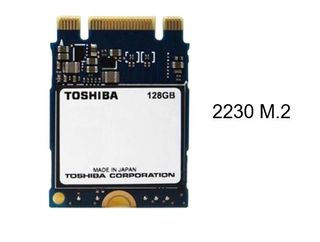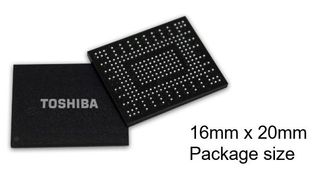UFS And NVMe Go Toe-To-Toe In Mobile, Toshiba Launches 3D BiCS NVMe SSDs
NVMe is a popular interface due to its increasing use in the client and enterprise space, so the perception that it is used only in hefty datacenter-class SSDs is gone. However, some are still surprised to find it used in mobile devices, such as phones, tablets and 2-in-1s.

Toshiba announced that it would have a live demo of its new BG series of products at the Flash Memory Summit 2016 next week. These new NVMe SSDs come in the smallest of form factors, such as small M.2 2230 (22x30mm) and BGA (Ball Grid Array) packages.
Toshiba introduced its first NVMe BGA package last year, and Marvell also introduced its own Alta Plus NVMe controller for embedded applications. Apple has used NVMe in many of its devices, including its phones, for some time, so the specification has traction in mobile use cases.
In the meantime, others are also migrating to the UFS specification, which allows for both embedded and removable cards, such as Samsung's latest UFS cards and phones. UFS and NVMe both have the ability to process read and write operations simultaneously (serial interface), which makes them more attractive than the parallel eMMC interface that appears to be fading into low-end mobile devices.

Toshiba/WD recently announced that its BiCS 3D NAND would come to market shortly. The new BG series NVMe SSDs come packing the highly-anticipated BiCS NAND, but Toshiba is being coy and not revealing if it's BiCS 2 or 3, though we do know that it is of the TLC variety, which increases density and reduces cost.
Toshiba touts the PCIe 3.0 x2 solution as 90 percent smaller than a normal 2.5" SSD and 82 percent smaller than a standard M.2 2280 SSD. The BGA package weighs only a gram (or less), but it still manages to cram in 126, 256 or 512 GB of capacity. Toshiba uses its own homegrown controllers, which allow it to infuse custom features that help increase performance and reduce power consumption (2.8W active/5mW idle).
“We are thrilled to unveil the new BG series with BiCS FLASH, which will deliver both a rich feature set and high performance all within an extremely small footprint and power profile,” said Jeremy Werner, vice president of SSD marketing and product planning, at Toshiba America Electronic Components, Inc. “We expect to be in production this year with BiCS FLASH BGA SSDs, offering our customers a compelling and cost-effective storage solution for the next generation of high performance ultra-thin and light notebooks and tablets.”
Stay On the Cutting Edge: Get the Tom's Hardware Newsletter
Join the experts who read Tom's Hardware for the inside track on enthusiast PC tech news — and have for over 25 years. We'll send breaking news and in-depth reviews of CPUs, GPUs, AI, maker hardware and more straight to your inbox.
The new Toshiba BG SSDs employ the HMB (Host Memory Buffer) NVMe functionality, which we covered in depth earlier this year. In short, HMB allows a DRAM-less SSD to utilize a portion of the system memory to cache its LBA lookup tables, which boosts performance and reduces overall power consumption and cost. HMB is promising, and we expect to see the tactic used widely in the future, but it requires BIOS and driver optimizations. Currently, there is no support in mainstream devices, so it is far from plug-and-play. Toshiba is working to assist OEMs in developing products that utilize the HMB functionality.

You can still use the SSD without HMB, but it will reduce performance significantly, which effectively eliminates the gains listed above. However, Toshiba did not reveal any hard performance data yet, but we will be sure to visit the demo at the Flash Memory Summit and update accordingly.

Toshiba's implementation uses only 32 MiB of host memory to manage a 16 GiB LBA range, which the company feels is enough to speed performance for most users. The BG SSDs also have only a small portion of the SSD LBA tables cached, which will have performance implications in case of cache "misses."
Some SSDs with limited DRAM also employ a similar tactic of caching only hot spots, but these tend to fall in the low-cost segment. The requirement for 32 MiB of DRAM to manage 16 GiB of NAND is interesting because most SSDs require 1 MB of DRAM for every 1 GB of NAND, and the Toshiba implementation is using twice as much. Toshiba mentioned that the driver is still in the optimization phase, but it will be interesting to see if other HMB solutions also require extra DRAM for table lookups.
The drives support TCG/Pyrite and TCG/Opal encryption, which is an important differentiator. Toshiba is currently sampling its BGA SSDs to a limited number of PC OEMs, but it will expand availability in 4Q 2016.

Paul Alcorn is the Managing Editor: News and Emerging Tech for Tom's Hardware US. He also writes news and reviews on CPUs, storage, and enterprise hardware.
-
I'm still looking for the cable interface that will replace SATA3. M.2 looks great on paper, but you are limited to 1-2 per motherboard. I need minimum of three drives per computer (dual redundancy). All these new technologies look great, but it's too much of a mess to upgrade.Reply
-
PaulAlcorn Reply18392157 said:I'm still looking for the cable interface that will replace SATA3. M.2 looks great on paper, but you are limited to 1-2 per motherboard. I need minimum of three drives per computer (dual redundancy). All these new technologies look great, but it's too much of a mess to upgrade.
Finding a decent cabled solution is dicey, too. The SATA committee has stated there will be no new (faster) SATA spec, so 3 is it.
SATA Express was DOA, there are no SSDs, though you can find a bunch of ill-advised motherboards that have ports for it.
U.2 was not DOA, but it is dead now pretty much for usual consumer stuff, though it is growing fast in the enterprise. There is still only one client-centric U.2 SSD (Intel 750), but it is overpriced and the cabling is ugly, at best. Perhaps they will come out with the OcuLink cables, which are the "planned" slim U.2 cables, but I wouldn't hold my breath. There are RAID controllers for NVMe coming soon, but unless vendors make more consumer U.2 SSDs it will not help. -
rhysiam Reply18392157 said:I'm still looking for the cable interface that will replace SATA3. M.2 looks great on paper, but you are limited to 1-2 per motherboard. I need minimum of three drives per computer (dual redundancy). All these new technologies look great, but it's too much of a mess to upgrade.
There are already boards with 3 M.2 slots for ultra high speed storage, like this one: http://www.newegg.com/Product/Product.aspx?Item=N82E16813157649&nm_mc=AFC-C8Junction&cm_mmc=AFC-C8Junction-PCPartPicker,%20LLC-_-na-_-na-_-na&cm_sp=&AID=10446076&PID=3938566&SID=
You can also chuck them in relatively cheap passive PCIe cards too. So with some careful hardware selection it's possible to get 4 or 5 at least without having to spend significant amounts of money.
There are x16 PCIe cards with 4xM.2 slots on them starting to appear (like this), but at present they require a PLX switch to address 4 separate x4 devices on the one x16 slot.. That's fairly niche at this stage, though so is requiring 6 + m.2 slots. -
glorfendel The issue with more M.2 or U.2 ports is pci lanes consumer gear has too few for and to slow to support 12 ports at 12 gbps or faster much less 10 m.2 ports. Once pcie 4 starts making it on to main boards this problem goes away. But with the density of SSDs going up so fast I would not expect to see more then 6 to 8 connections. any more would be reserved for servers and storage appliances. but at the rate things are going external connections will rival internal in a year or 2 anyway.Reply -
tiagoluz8 And there's also 3D XPoint which brings storage closer to RAM speeds. I'd love to see a motherboard with RAM-like slots for 3D Xpoint storage (4x SO-DIMM sized, right under the CPU, above the first PCI-E slot).Reply
